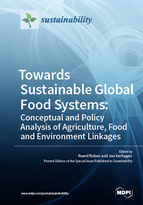Towards Sustainable Global Food Systems : Conceptual and Policy Analysis of Agriculture, Food and Environment Linkages
A special issue of Sustainability (ISSN 2071-1050). This special issue belongs to the section "Sustainable Agriculture".
Deadline for manuscript submissions: closed (31 December 2018) | Viewed by 117565
Special Issue Editors
Interests: food systems, impact analysis, farm-household economics, value chains
Special Issue Information
Dear Colleagues,
One of the major knowledge challenges in the domain of Resilient and Sustainable Food Systems refers to the integration of perspectives on consumption, patterns that support public health, inclusive value chains and environmentally sustainable food production. While there is a long record of analysing separate interventions, this special issue generates integrated insights, provides cross-cutting perspectives and outlines practical and policy solutions that address these global challenges.
The collection of papers promotes the view that sustainable food systems requires thorough insights into the structure and dynamics of agro-food production systems, the drivers for integrating food value chains and markets, and key incentives for supporting healthier consumer choices. At the production side, potential linkages between agricultural commercialisation and intensification and their effects for food security and nutritional outcomes are analysed. Value Chains are assessed for their contribution to improving exchange networks and markets for food products that simultaneously support efficiency, circularity and responsiveness. Individual motives and market structures for food consumption need to be understood in order to be able to outline suitable incentives to enhance healthy dietary choice.
The contributed papers focus on interfaces between food system activities and processes of adaptive change that are critical for overcoming key constraints and trade-offs between sustainable food and healthy diets.
Prof. Dr. Ruerd Ruben
Dr. Jan Verhagen
Guest Editors
Manuscript Submission Information
Manuscripts should be submitted online at www.mdpi.com by registering and logging in to this website. Once you are registered, click here to go to the submission form. Manuscripts can be submitted until the deadline. All submissions that pass pre-check are peer-reviewed. Accepted papers will be published continuously in the journal (as soon as accepted) and will be listed together on the special issue website. Research articles, review articles as well as short communications are invited. For planned papers, a title and short abstract (about 100 words) can be sent to the Editorial Office for announcement on this website.
Submitted manuscripts should not have been published previously, nor be under consideration for publication elsewhere (except conference proceedings papers). All manuscripts are thoroughly refereed through a single-blind peer-review process. A guide for authors and other relevant information for submission of manuscripts is available on the Instructions for Authors page. Sustainability is an international peer-reviewed open access semimonthly journal published by MDPI.
Please visit the Instructions for Authors page before submitting a manuscript. The Article Processing Charge (APC) for publication in this open access journal is 2400 CHF (Swiss Francs). Submitted papers should be well formatted and use good English. Authors may use MDPI's English editing service prior to publication or during author revisions.
Keywords
- Food Systems
- Agriculture
- Nutrition
- Sustainability






